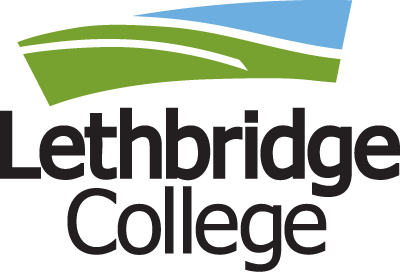It’s a crisp December morning on the Piikani Nation in southwest Alberta. A herd of buffalo has circled around a female member laying in the snow. One by one they attempt to rouse her, but none are able. They gallop away as a group, stopping once to look back.
“I felt a presence,” says Lowell Yellowhorn (Spiitawakasi/Tall Deer), Lethbridge College’s Indigenous Services manager. “It was as if they were saying ‘she’s with you now; take her.’ It was emotional, and I felt the spirit of that animal.”
“And her spirit is still here,” says Marni Hope (Miisomii’kitsikaakii/Long Time Offering), Indigenous student support and events coordinator. “We are so reciprocal in our thinking that I imagined the herd knew we would do something good with her and that it would come back to them. And look at all she’s given us.”
Tangible gifts from the hunt that day include a new Winter Count Robe – a pictorial history of the college painted on a buffalo hide – and a sizeable donation of meat, given to the Piikani Nation food bank just in time for Christmas. As significant as these gifts are in their physical forms, they are also symbolic of the intangible gifts given that day – some are unique to those who are part of the story, but all can serve as inspiration to those who hear it.
Acquiring a buffalo robe for Lethbridge College was something the Indigenous Services team had been considering long before connecting with the Piikani Nation in late 2022. The idea initially stemmed from their participation in the McConnell Foundation’s Social Innovation Lab on Reconciliation in the
Postsecondary Education Sector.
Lethbridge College and Algoma University in Ontario were the only two postsecondary institutions to take part in the pilot project, which launched in the fall of 2021. Each regional team was asked to tackle a specific opportunity facing them in their efforts for reconciliation.
For the Lethbridge group, lab sessions incorporated both Blackfoot worldviews and western worldviews, as members worked to identify opportunities to incorporate Indigenous ways of knowing into curriculum and a method and practice for teaching adult learners. Out of that approach came a focus on preserving Indigenous culture and language – specifically the Blackfoot language.
As part of the process, members of the college community came together, including Provost and Vice President – Academic Dr. Samantha Lenci; members of the Indigenous Services team; and other college colleagues, including Kristen DeMone, who had been part of the social innovation lab experience. Their work was focused on reconciliation, and as part of that, they visited Blackfoot Crossing Historical Park and Old Sun College on Siksika Nation as well as Red Crow College on Kainai Nation. In their travels, they noticed a theme – all had Winter Count Robes telling their stories.

“We noted during the lab, that in order to have reconciliation, you have to go back and reflect on the truth,” says Yellowhorn. “As an educational institution for several frontline workers including police, nurses and child and youth care specialists, we have to look at some hard truths – what was our role in the colonization process and how are we going to address it and fix it.”
Wanting the college to be a catalyst for change, the Indigenous Services team felt a Winter Count Robe would not only be a prominent symbol of traditional Blackfoot Territory on campus, but it would also reaffirm the close relationship between the college and Indigenous communities in southern Alberta – specifically the Piikani and Kainai First Nations.
“They are two of the largest partners in this institution,” explains Yellowhorn. “The education people receive here is driving those communities and leading the way for Indigenous communities across Canada.”
As a result of that longstanding relationship, the college was given the opportunity to harvest a buffalo from the Piikani herd and to use the hide for a Winter Count. After consultations with the college’s Executive Leadership Team, Yellowhorn made the arrangements.
For Yellowhorn and Hope, the hunt was a chance to connect with their roots, to feel even deeper that sacred relationship from centuries past when buffalo were essential to life – providing food, clothing and shelter for entire tribes.
“We did it in a culturally appropriate way,” Yellowhorn says. “We sat down, and we engaged in ceremony with the cultural community. Cultural practitioners, elders, and some key influential grandfathers from the Blackfoot Confederacy were there guiding us, and we had their blessing to harvest the animal.”
Yellowhorn offered the Lethbridge College pipe to an elder and spoke in the Blackfoot language. He asked him to pray for the Blackfoot people and for the college, and to ensure the hunting party was moving forward in a good way. Yellowhorn says he also emphasized the importance of the buffalo robe to the Indigenous community at Lethbridge College.
“It’s about representation for our students and creating a safe place,” he says. “You may think ‘well it’s just one Indigenous student’ but that student could have 15 people relying on him or her to get an education and provide for the family. These types of decisions save lives.”
“Sharing those cultural stories and land-based learning skills are an important part of our identity as Blackfoot people,” adds Hope. “We have an identity crisis because of colonization, so any time we get the opportunity to go back to our ways, it builds self-esteem and connection to the territory.”
Joining Yellowhorn, Hope and Kainai Kaahsinnoonik (grandparent) Peter Weasel Moccasin (Miiniipooka/Berry Child) from Lethbridge College was Dr. Terry Kowalchuk, Dean of the Centre for Technology, Environment and Design. He was personally invited by Yellowhorn, and was the only non-Indigenous member in the group of 20 or more people.
“I’ve hunted, fished, trapped and lived off the land my entire life,” says Kowalchuk, “but when Lowell asked me to join him and a party of Blackfoot hunters, it was very special.”

Kowalchuk wasn’t only there to observe. With years of experience field dressing large animals, he took the lead when the time came, and shared his knowledge with the others as they moved through the process. “We were all there to listen,” says Hope. “Terry was such a part of it all, even though he was the only non-Indigenous person there, it didn’t matter. He had things to share and to teach us and it almost felt like he was an honorary member in that moment.”
With several young men from Piikani Nation also eager to assist, Kowalchuk turned over his knife and guided them as they helped process the buffalo. “We didn’t want to cut the hide too much, but we also recognize we are a learning institution,” says Kowalchuk. “Sometimes little mistakes are made in the process and when you see the hide, there’s a few nicks and holes and that’s OK – that’s us, that’s our story.”
The learning continued back at Lethbridge College as Culinary students, in both diploma and apprenticeship programs, broke down the carcass into steak, roast, ground, stew and stir-fry cuts. The meat was packaged into small one-kilogram bags and given back to the Piikani Nation for distribution through the local food bank. “That’s reciprocity,” says Yellowhorn. “We came back together to deliver the successes of the hunt and engage in ceremony. It was a sacred protocol that reaffirmed the relationship between the college and Piikani Nation.”
Kowalchuk, meanwhile, spent 10 hours or more fleshing the buffalo hide (scraping away any remaining tissue) at his home workshop before bringing it to the college’s necropsy lab in the School of Environmental Sciences. That’s where student and employee volunteers helped prepare the hide for preservation.
Part of the tanning process also involves “working” the hide as it dries, which breaks up the fibrous sinew so it doesn’t harden. It’s an essential but demanding job. Volunteers took turns over several days, pulling the hide back and forth over a beam – an activity that caught the attention of a passing student.
“My buddy Adam (Pasowisty) and I were walking the halls between classes one day, and I noticed some people breaking-in a buffalo hide,” says Scott Braun, Natural Resource Compliance student. “I’ve tanned a couple of animal hides myself, and Adam is getting into it, so we asked if we could watch.”
Braun says he shared some of his experiences with the group and suggested an alternate method of tanning – to rub a fine grit rock over the leather side of the hide. He touched base a few days later and was told his advice had “worked perfectly.”
“I grew up in Grande Prairie hunting and fishing, and I believe in honouring the animal to its fullest extent by using everything you can, including the hide,” says Braun. “It means a lot to me that I was able to help out and share a skill that’s been lost by a lot of hunters. I hope more people are encouraged to get back to that tradition.”
At the end of the tanning process, when the hide was ready to tell the college’s story, the robe was handed over to Blackfoot artist William Singer III (Api’soomaahka/Running Coyote) to paint the Winter Count.
The robe will be on permanent display in the Trades, Technologies and Innovation Facility and will be featured prominently at several annual campus events including convocation, Stone Pipe Days, the Ohkotoki’aahkkoiyiiniimaan Powwow and more. (Read about Singer’s work on page 24.)
“It’s inspirational,” says Yellowhorn. “It may look like simple art when you see it, but it’s meaningful and it instills pride. And when my grandkids and great-grandkids ask, I can step up and say, ‘this is what we did; this was part of our reconciliation process.’”
Kowalchuk says the experience – from start to finish – has not only been the highlight of his time at Lethbridge College, but the highlight of his entire hunting career. “As a biologist who is professionally trained to understand the relationships between living things, and as someone who has grown up immersed in nature, this was the other piece,” he says. “I was invited by someone I respect, to play an active role and to be part of a true hunter-gatherer society. It was spiritual and it was once in a lifetime.”
Hope says she still feels a deep connection to the buffalo and wants to ensure the robe makes its way back to Piikani from time to time. She also hopes to share its story with students, employees and community members as often as possible. “It’s really an opportunity to teach,” she says. “Maybe it encourages a student to ask more questions about the ceremony or why it’s significant. It can open the door for further discussion.”
Yellowhorn agrees. “We need to keep asking questions. Just like the path of the buffalo, it won’t be a straight line. But we’re all on this journey together.”



